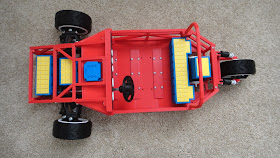I am amazed that this project is already completed this morning. No major problems and the assembly went together without a hitch. Not to say that 126 hours of designing this project did not help with all of this coming together correctly. Add to this another 150 hours of making and assembling parts. This brings the grand total of hours in this project to 276 hours. Whew! A lot of fun to figure out this design and see it all come together though. Here are are the final photos of the model.
This photo is the two part assembly for the head rests for the seats. The two holes in the bottom of the red outer part will receive the aluminum mounting pins for the headrest to be positioned on to the seats.
Here the seat back parts are laid out to show you the assembly. No glue was needed in the assembly of any of the parts of the seat. All of the parts snapped right into place and are tight enough so gluing them together simply was not needed.
The seat backs are completed with the headrests and white inserts mounted. It really makes the seats stand out with the contrasting colors.
This photo is of one of the seat bottoms. These two parts alone for one seat took a little over six hours to print using the Makerbot 3D printer. It was a real nail biter while printing the last seat bottom with the red plastic. I had very little left on the spool and was afraid that I would run out of plastic before it completed. I had more red plastic on hand but it was not the same shade of red. Luckily it printed out just fine and I was able to complete the assembly with no problems.
These three photos are some good shots of the model by itself and a figure in the drivers seat.
These last two photos are of the belt drive system that ties the electric motor to the rear wheel. The belt was printed on the Makerbot 3D printer and is not flexible. The pulleys are made in two parts so that the belt could be mounted onto the motor and the drive system. It all turned out very well.
One last photo. I think the underside of the model looks just as good as the top side. As you can see, lots of machine screws to hold it all together. Pretty though don't you think?
The next step will be to possibly build a fiberglass body for the model. I have a couple ideas as to how this can be done but as yet have not started work on it. I think I will sit back and admire my efforts for now and do some thinking on the next phase of this project. I hope you've enjoyed the photos and info that I've passed on to you over the past month or so. If I get the body figured out I will post that as well and keep you up to date. Either way I think my efforts on this project have once again turned out very well so it's all good.



















































